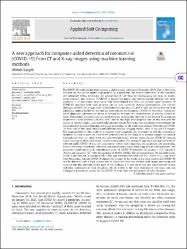| dc.contributor.author | Saygılı, Ahmet | |
| dc.date.accessioned | 2022-05-11T14:03:00Z | |
| dc.date.available | 2022-05-11T14:03:00Z | |
| dc.date.issued | 2021 | |
| dc.identifier.issn | 1568-4946 | |
| dc.identifier.uri | https://doi.org/10.1016/j.asoc.2021.107323 | |
| dc.identifier.uri | https://hdl.handle.net/20.500.11776/4570 | |
| dc.description.abstract | The COVID-19 outbreak has been causing a global health crisis since December 2019. Due to this virus declared by the World Health Organization as a pandemic, the health authorities of the countries are constantly trying to reduce the spread rate of the virus by emphasizing the rules of masks, social distance, and hygiene. COVID-19 is highly contagious and spreads rapidly globally and early detection is of paramount importance. Any technological tool that can provide rapid detection of COVID-19 infection with high accuracy can be very useful to medical professionals. The disease findings on COVID-19 images, such as computed tomography (CT) and X-rays, are similar to other lung infections, making it difficult for medical professionals to distinguish COVID-19. Therefore, computer-aided diagnostic solutions are being developed to facilitate the identification of positive COVID-19 cases. The method currently used as a gold standard in detecting the virus is the Reverse Transcription Polymerase Chain Reaction (RT-PCR) test. Due to the high false-negative rate of this test and the delays in the test results, alternative solutions are sought. This study was conducted to investigate the contribution of machine learning and image processing to the rapid and accurate detection of COVID-19 from two of the most widely used different medical imaging modes, chest X-ray and CT images. The main purpose of this study is to support early diagnosis and treatment to end the coronavirus epidemic as soon as possible. One of the primary aims of the study is to provide support to medical professionals who are most worn out and working under intense stress during COVID-19 through smart learning methods and image classification models. The proposed approach was applied to three different public COVID-19 data sets and consists of five basic steps: data set acquisition, pre-processing, feature extraction, dimension reduction, and classification stages. Each stage has its sub-operations. The proposed model performs in considerable levels of COVID-19 detection for dataset-1 (CT), dataset-2 (X-ray) and dataset-3 (CT) with the accuracy of 89.41%, 99.02%, 98.11%, respectively. On the other hand, in the X-ray data set, an accuracy of 85.96% was obtained for COVID-19 (+), COVID-19 (-), and those with Pneumonia but not COVID-19 classes. As a result of the study, it has been shown that COVID-19 can be detected with a high success rate in about less than one minute with image processing and classical learning methods. In the light of the findings, it is possible to say that the proposed system will help radiologists in their decisions, will be useful in the early diagnosis of the virus, and can distinguish pneumonia caused by the COVID-19 virus from the pneumonia of other diseases. © 2021 Elsevier B.V. | en_US |
| dc.language.iso | eng | en_US |
| dc.publisher | Elsevier Ltd | en_US |
| dc.identifier.doi | 10.1016/j.asoc.2021.107323 | |
| dc.rights | info:eu-repo/semantics/openAccess | en_US |
| dc.subject | CAD | en_US |
| dc.subject | COVID-19 | en_US |
| dc.subject | CT | en_US |
| dc.subject | Machine learning | en_US |
| dc.subject | X-ray | en_US |
| dc.subject | Classification (of information) | en_US |
| dc.subject | Computer aided diagnosis | en_US |
| dc.subject | Computer aided instruction | en_US |
| dc.subject | Machine learning | en_US |
| dc.subject | Medical imaging | en_US |
| dc.subject | Polymerase chain reaction | en_US |
| dc.subject | Alternative solutions | en_US |
| dc.subject | Classification models | en_US |
| dc.subject | Computer aided detection | en_US |
| dc.subject | Computer aided diagnostics | en_US |
| dc.subject | Machine learning methods | en_US |
| dc.subject | Medical professionals | en_US |
| dc.subject | Reverse transcription-polymerase chain reaction | en_US |
| dc.subject | World Health Organization | en_US |
| dc.subject | Computerized tomography | en_US |
| dc.title | A new approach for computer-aided detection of coronavirus (COVID-19) from CT and X-ray images using machine learning methods | en_US |
| dc.type | article | en_US |
| dc.relation.ispartof | Applied Soft Computing | en_US |
| dc.department | Fakülteler, Çorlu Mühendislik Fakültesi, Bilgisayar Mühendisliği Bölümü | en_US |
| dc.identifier.volume | 105 | en_US |
| dc.institutionauthor | Saygılı, Ahmet | |
| dc.relation.publicationcategory | Makale - Uluslararası Hakemli Dergi - Kurum Öğretim Elemanı | en_US |
| dc.authorscopusid | 55807379700 | |
| dc.identifier.wos | WOS:000663087100019 | en_US |
| dc.identifier.scopus | 2-s2.0-85102881385 | en_US |



















